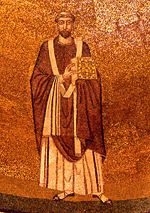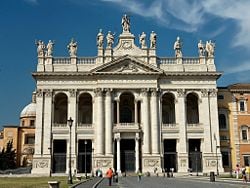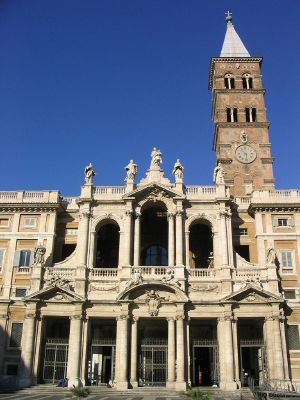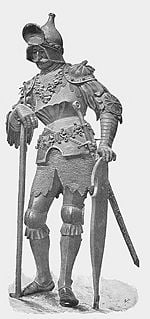Pope Symmachus
| Saint Symmachus | |
|---|---|

| |
| Birth name | Symmachus |
| Papacy began | November 22, 498 |
| Papacy ended | July 19, 514 |
| Predecessor | Anastasius II |
| Successor | Hormisdas |
| Born | ??? Sardinia, Italy |
| Died | July 19 514 Rome |
Pope Saint Symmachus was pope from 498 to 514. He was born on Sardinia and was baptized in Rome, where he became archdeacon under Pope Anastasius II. Symmachus was active during the Acacian schism, a period of intense friction between the churches of Constantinople and Rome over the issue of Monophysitism. He thus faced a serious rival claimant to the throne of Saint Peter in the person of the archpriest Laurentius, who led a faction less opposed to Constantinople. King Theodoric the Great eventually decided against Laurentius and in favor of Symmachus.
In 501, however, Symmachus faced accusations of major crimes, including fornication and financial corruption. The pope refused to appear to answer the charges at a church synod called by Theodoric. After several meetings, the assembled bishops decided that the judgment of the pope must be left to God alone. Theodoric now supported Laurentius, who held the Lateran Palace as pope, while Symmachus lived at Saint Peter's, then less grand and located outside the city walls. The schism continued for four years, resulting in both violence and the creation of documents known as the Symmachian forgeries. Theodoric, probably for political reasons, eventually withdrew his support of Laurentius and had him banished from Rome. Symmachus thus finally emerged as the sole pope c. 505.
Symmachus contributed large sums for the support of the Catholic bishops of Africa who were persecuted by the rulers of the Arian Vandals. His opposition to Monophysitism during the Acacian schism won him the respect of later Eastern Orthodoxy, and he is thus venerated as a saint in both the Catholic and Orthodox traditions.
Life
According to the "Liber pontificalis" Symmachus was a native of Sardinia and his father was named Fortunatus. His family was apparently not a Christian one, for Symmachus was baptized at Rome, where he later entered the ranks of the clergy of Rome and was ordained deacon. During this time, the Acacian schism raged between Rome and Constantinople, named after the patriarch of Constantinople, Acacius. The Roman church had favored a hard line against Monophysitism, while Constantinople supported the Henotikon of Emperor Zeno, a theological document which attempted reconciliation between the Monophysites and orthodoxy.
Disputed election
Symmachus' election was an extremely contentious one due to rival factions at Rome. One of these supported reconciliation with Constantinople; the other insisted that the Henotikonâdevised by Emperor Zeno and Patriarch Acacius and expressly avoiding the question of whether Christ had one or two natures (divine and human)âin effect endorsed the Monophysite heresy as orthodox. Directly after the death of Pope Anastasius II, Symmachus was elected his successor by one faction of the Roman clergy at the Lateran Basilica, on November 22, 498. He was at once consecrated bishop of Rome. However, later on the same day, a rival faction, more friendly to Constantinople, met in the Basilica of Santa Maria Maggiore and elected the Roman archpresbyter Laurentius to the same position. Each party was supported by its own faction in the Roman Senate. The Laurentian party received important support from the wealthy Senator Festus, who hoped that Laurentius, as pope, would sign the Henotikon.
The two parties agreed that the candidates should appear at Ravenna before the King Theodoric, the ruler of Italy, and abide by his decision. Theodoric pronounced in favor of Symmachus, on the grounds that he was elected first and by the majority of the clergy. Laurentius submitted to this decision. At a synod held at Rome on March 1, 499, Symmachus appointed Laurentius bishop of the diocese of Nocera in Campania. The synod also decided that any Roman cleric who sought to gain votes for a successor to the papacy during the lifetime of the pope should be deposed. King Theodoric, himself an Arian Christian and thus a heretic, was given a vote of thanks by acclamation for his unbiased decision. When the king came to Rome in the following year, he was given an enthusiastic reception both from the pope and the people.
Continuing controversy
However, the pro-Constantinople party, headed by the senators Festus and Probinus, did not abandon its hope of ousting Symmachus and gaining the papal see for Laurentius. Their opportunity occurred in 501, as Symmachus' conduct in office had raised issues regarding both his policies and his behavior. Policy-wise, Symmachus celebrated Easter on March 25, following the Roman tradition, while the Byzantines and others observed the feast on April 22, according to a new reckoning. The Laurentian party appealed to King Theodoric against the pope. Even more serious, Symmachus also stood accused of financial corruption and fornication.
Theodoric summoned the pope for a hearing, and Symmachus set out to meet him at Ravenna. On the way, Symmachus learned the contents of the indictment against him. Perhaps seeing the cards stacked against him, he now refused to acknowledge the kingâwhose ruling in his favor he had been happy to accept earlierâas his judge, and returned home. The pro-Larentius faction now gained in strength and occupied the Lateran palace, so that the Symmachus was obliged to live near the Church of Saint Peter outside the city walls. His opponents requested that the king to call a synod of bishops for the investigation of the accusations and to appoint a visitor (royal overseer) for the Roman church. Symmachus agreed to the calling of a synod, but he and his adherents protested against the appointment of a visitor. Theodoric, however, sent as visitor Bishop Peter of Altinum, from northern Italy, who was to administer the Roman church in the place of the accused pope.
When Peter came to Rome, he sided with the adherents of Laurentius. Not long after Easter, between May and July 502, the aforementioned synod met in Santa Maria in Trastevere. The pope declared before the council that it had been called with his consent and that he was ready to answer the accusations before it. He insisted as a precondition, however, that the visitor must be removed and that he, the pope, should be re-established as the administrator of the Roman church. To this the majority of the bishops agreed and sent an embassy to support this policy. Theodoric, however, refused. He demanded that the investigation of the accusations against Symmachus proceed before any decision was made about the leadership of the church in Rome.
A second session of the synod was held on September 1, 502, in the Sessorian basilica (Santa Croce in Gerusalemme). The indictment against Symmachus was read aloud. Symmachus reportedly attempted to leave Saint Peter's and go to the synod in order to defend himself, but on the way he was attacked by a pro-Laurentius mob, escaping only with great difficulty and returning to Saint Peter's. Several priests who were with him were reportedly killed or severely wounded. Theodoric sent soldiers who promised Symmachus a reliable escort in the future, but the pope now refused to appear before the synod, although he was formally invited three times.
At the synod's third session, held about the middle of September 502, the majority of the assembled bishops decided they they could not pass judgment upon the pope, on the grounds that there was no precedent showing that a previous bishop of Rome had been subjected to the judgment of other bishops. They called upon the opposing clergy to submit to the pope and requested that the king permit the bishops to return to their dioceses. These requests were rebuffed.
A fourth session was held on October 23, 502, called the "Synodus Palmaris." At this session the bishops decided again that the issue must be left to the judgment of God. Without saying yes or no on the question of Symmachus' alleged crimes, it restored him to his former position. Symmachus was thus to be regarded as free from accusation, and therefore entitled to the full exercise of his episcopal office. The whole property of the church was to be transferred to him. The majority declared that whoever returned to his obedience to the pope would escape punishment, but whoever undertook ecclesiastical functions at Rome without papal permission was to be regarded as a schismatic. The decision was signed by 75 bishops, among them the powerful bishops of Milan and Ravenna. Many bishops now returned to their dioceses. The majority, however, met with the Roman priests in Saint Peter's for a fifth session under the presidency of Symmachus on November 6, 502.
King Theodoric, not at all satisfied with the decision, did nothing to carry out its decisions and continued to support Laurentius. Consequently the opposition felt free to invite Laurentius to come again to Rome. He did so, residing in the Lateran palace, while Symmachus retained the house of the bishop near Saint Peter's. These rival papacies continued for four years, during which both parties carried on a furious quarrel at Rome, sometimes erupting into violence. Laurentius had his portrait added to the series of popes in the Church of Saint Paul outside the Walls.
Symmachus becomes sole pope
However, various prominent persons exerted their influence in favor of Symmachus as well. Bishop Avitus of Vienne, for example, addressed an urgent letter to the Senate on behalf of the Symmachus and for the restoration of unity under the "rightful" pope. Gradually, Symmachus won over a number of adherents of the opposition.
During the dispute, the adherents of Symmachus drew up four apocryphal writings known as the "Symmachian Forgeries." The object of these works was to produce alleged instances from earlier times in support especially of the position that the Roman bishop could not be judged by any court composed of other bishops. A number of polemical writings also appeared, such as the pro-Laurentian treatise Contra Synodum absolutionis incongruae, and the opposing Libellus adversus eos qui contra Synodum scribere praseumpserunt. The author of the life of Symmachus in the Liber Pontificalis is very favorable to this pope; however, part of another biography also included in the Liber which supports the cause of Laurentius.
The greatest factor in the resolution of the schism was the interposition of Dioscorus, a deacon from Alexandria, who had come to Rome. He was commissioned by Symmachus to go to Theodoric and succeed in winning over the king to accept Symmachus as the rightful pope. Political motives were clearly involved on Theodoric's part, for he had come to see the Laurentian party as too much on the side of Constantinople. Moreover, the tide in Rome itself was turning against Laurentius. Theodoric commanded Senator Festus, therefore, to return the pro-Larentius churches to Symmachus. The defeated "antipope" was obliged to leave Rome and retired to a farm belonging to Festus. Some Romans still refused to recognize Symmachus as their bishop, and thus the schism would not be fully healed until the reign of his successor, Hormisidas.
Acacian schism
The controversy at Rome tends to overshadow the role that Symmachus played in the broader theological struggle that raged throughout Christendom, especially in the East. He zealously defended the anti-Monophysite party during the conflict of the Acacian schism. In a letter to Emperor Anastasius I (491-518), he defended the opponents of the Henotikon, although without success. The Emperor was determined to put an end to the divisive debate over the question of Christ's natures, and the Henotikon had been designed to accomplish this.
At a later date many of the eastern bishops who suffered for resisting the imperial policy they must sign the Henotikon wrote to the pope for both spiritual and political support, sending him their confession of faith. Early in 507, the emperor wrote to Symmachus in a letter full of invectives for daring to interfere both with imperial policy and the rights of the eastern patriarch, to whom he was superior in honor only. The pope replied with an equally firm answer, maintaining in the strongest terms the rights of the Roman church as the representative of Saint Peter.
In a letter of October 8, 512, addressed to the bishops of Illyria, the pope warned the clergy of that province not to hold communion with Monophysite "heretics," a direct assault on the principles of the Henotikon.
Other activities and accomplishments
Soon after the beginning of his pontificate, Symmachus interposed in the quarrel between the archbishops of Arles and Vienne as to the boundaries of their respective territories. He annulled the edict issued by Pope Anastasius II in favor of the archbishop of Vienne and later confirmed the rights of Archbishop Caesarius of Arles, on the grounds that these had been established earlier by Pope Leo I. Moreover, he granted Caesarius the privilege of wearing the palliumâan ecclesiastical cloak previously associated mainly with the pope himselfâthe first-known instance of such a grant to a bishop outside of Italy. In a letter of June 11, 514, he appointed Caesarius to represent the interests of the Church both in Gaul and Spain, to hold synods of the bishops in certain cases, to give letters of recommendation to clergy who journeyed to Rome.
In the city of Rome, the pope took severe measures against the Manichæans, ordered the burning of their books, and expelled them from the city. He also erected or restored and adorned various churches of the orthodox faith. Thus he built a Church of Saint Andrew near Saint Peter's and a basilica of Saint Agnes on the Via Aurelia. He also adorned the Church of Saint Peter's, completely rebuilt the Basilica of Saints Sylvester and Martinus, and made improvements over the Catacomb of the Jordani on the Via Salaria. He built episcopal houses near Saint Peter's. He also built asylums for the poor near the churches of Saint Peter, Saint Paul, and Saint Laurence outside the city walls.
Symmachus contributed large sums for the support of the Catholic bishops of Africa who were persecuted by the rulers of the Arian Vandals. He also aided the inhabitants of the provinces of upper Italy who suffered so sorely from the invasion of the "barbarians." After his death he was buried at Saint Peter's.
Legacy
Symmachus left a troubled legacy. Although he was supported by the majority of the Roman clergy, he faced opposition from one of the most successful "anti-popes" in history in the person of Laurentius. Although Symmachus proved victorious in this struggle, the conflict severely harmed the reputation of the Christian faith as the religion of brotherly love. Moreover, he left the accusation of serious financial impropriety and sexual misconduct hanging over his papacy.
Symmachus also faced divisions within the church over the so-called Acacian schism. Here his record was more successful, as he strongly continued the Roman tradition of asserting papal primacy over Constantinople. Since Monophysitism was eventually defeated, the Roman position on this matter proved to be the "correct" one, and his insistent opposition to the Henotikon and its supporters won him respect in the East as well as the West.
Symmachus is thus venerated as a saint in both the Catholic and Orthodox traditions. His feast day is on July 19.
| Roman Catholic Popes | ||
|---|---|---|
| Preceded by: Anastasius II |
Bishop of Rome 498â514 |
Succeeded by: Hormisdas |
ReferencesISBN links support NWE through referral fees
- Alberigo, Giuseppe. The Oecumenical councils from Nicaea I to Nicaea II (325-787). Turnhout: Brepols, 2006. ISBN 9782503523637.
- Chapman, John. Studies on the Early Papacy. Port Washington, NY: Kennikat Press, 1971. ISBN 9780804611398.
- Cunningham, Agnes. The Early Church and the State. Sources of Early Christian thought, 4. Philadelphia: Fortress Press, 1982. ISBN 9780800614133.
- Frend, W.H.C. The Rise of the Monophysite Movement. James Clarke Company, 2008. ISBN 978-0227172414.
- Fortescue, Adrian. The Reunion Formula of Hormisdas. Garrison, NY: National Office, Chair of Unity Octave, 1955.
- Heather, P.J. The Fall of the Roman Empire: A New History of Rome and the Barbarians. New York: Oxford University Press, 2006. ISBN 9780195159547.
- Kreilkamp, Hermes. Rome and Constantinople in the Fifth Century: A Study in the Relationships of Patriarchal Churches. Washington, D.C.: School of Canon Law, Catholic University of America, 1971.
- Loomis, Louise Ropes. The Book of the Popes: To the Pontificate of Gregory I. Merchantville, NJ: Evolution Pub., 2006. ISBN 9781889758862.
| |||||||||||||
Credits
New World Encyclopedia writers and editors rewrote and completed the Wikipedia article in accordance with New World Encyclopedia standards. This article abides by terms of the Creative Commons CC-by-sa 3.0 License (CC-by-sa), which may be used and disseminated with proper attribution. Credit is due under the terms of this license that can reference both the New World Encyclopedia contributors and the selfless volunteer contributors of the Wikimedia Foundation. To cite this article click here for a list of acceptable citing formats.The history of earlier contributions by wikipedians is accessible to researchers here:
The history of this article since it was imported to New World Encyclopedia:
Note: Some restrictions may apply to use of individual images which are separately licensed.



